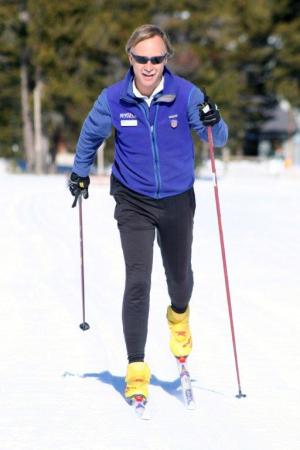Here’s a Must-Read for Seniors Before They Head for the Slopes.
Paul Petersen, who begins his 38th season running Bear Valley Cross-Country in California this winter, is 56 years old and comes with the kind of credentials that should make you sit up and take note of what he has to say! He’s been a certified alpine and cross-country ski instructor for nearly four decades. He’s also the former coach of the national nordic team of the Professional Ski Instructors of America and is currently on its education advisory committee.
“I’m a fully addicted skiaholic, and I don’t see that getting better any time soon,” avows Petersen. “It’s one of the most fun things you can do in life outdoors.”

He’s made “staying in the game of skiing a life goal,” and he’d like to help you do the same. First and foremost, plan ahead. You can’t just hit the slopes or trails without any preparation after several months of not skiing. Start with exercises that simulate the movements you make when you ski or snowboard. Here are Petersen’s four cornerstones to focus on in the weeks before the wintersports season begins:
- BALANCE: Stand on one foot, moving from foot to foot every 15 seconds or so multiple times; look for other balance-focused exercises you can do easily anywhere, any time.
- STRENGTH: Simulate a chair—every skier’s “go to” thigh-strengthening exercise! Slide your back down a wall so that your hips and knees are at right angles. Hold for as long as you can stand it, slide back up, and repeat! Check out other leg and trunk strengthening exercises, such as lunges and squats.
- FLEXIBILITY: Streeeeetch! Do yoga, or any other stretching exercises you’re comfortable doing.
- CARDIO: Take the stairs. Park in the farthest parking space in parking lots. Walk around two or three blocks several times a week. Run in place.
What about fitness classes? Paul recommends aerobics for cross-country skiers to enhance cardio and yoga for downhill skiers/boarders to stretch out tight muscles and loosen joints.
And don’t forget about pre-season equipment safety. What good will it do you to plop your fit-as-a-fiddle body atop skis that negate all the prep? It’s worth the money to get your skis tuned up ahead of time, getting the edges sharpened, and most importantly, having your binding settings checked to be in sync with your age, current weight, and ability—all of which might have changed since the last time you had your bindings checked.
Not a big fan of helmets? After all, you’ve skied unencumbered by headgear for eons without any ill effects. Petersen says, “It’s a no-brainer [pun not intended]…wear a helmet! It keeps you warmer, and it doesn’t affect your balance or equilibrium. It’s not so much that you might hit a tree, but rather that some out-of-control newbie snowboarder can come crashing into you.” Petersen also suggests buying some of the incredibly well-designed sports padding that’s available today, such as padded shorts that protect one’s hips, which are particularly vulnerable as we age, and wrist guards for snowboarders.
Editor Note: Petersen also has a lot of excellent tips for the day before you ski and things that are very important to do the morning of. But that’s another whole article for another day…watch for it coming soon!











